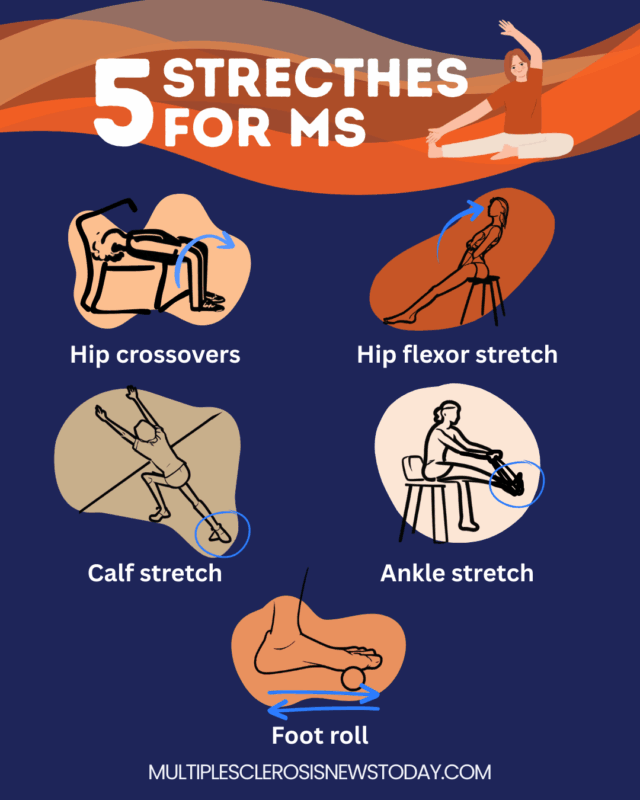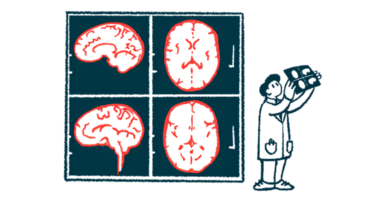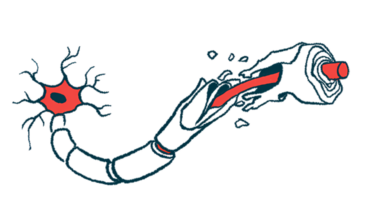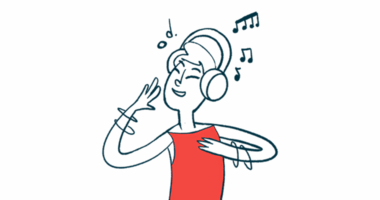5 stretches for MS spasticity
Last updated Jan. 15, 2025, by Susie Strachan

Gentle stretches can help you manage spasticity, a common symptom of multiple sclerosis (MS) that causes muscles to feel abnormally tight and stiff. As many as 90% of people living with MS will experience spasticity at some point.
Muscle spasticity and MS can make it harder to move and increase your chances of falling.
Stretching exercises for MS can help with MS spasticity, relieve pain and muscle spasms, improve mobility, and support your independence and quality of life.
Before starting any MS stretches, talk to your doctor or a physical therapist about which exercises are best for you.

How stretching helps MS spasticity
Stretches for MS spasticity can help loosen tight muscles and improve flexibility, which can also reduce the frequency and intensity of spasms that often accompany muscle stiffness.
Symptoms of MS spasticity occur when nerve signals between your brain and muscles are disrupted by MS-related damage.
When nerve signals are disrupted, your body may compensate for the resulting muscle weakness by increasing muscle tone. This causes your muscles to become tight, stiff, or prone to spasms, which are sudden, involuntary muscle movements. MS spasticity can be uncomfortable and painful.
MS spasticity affects everyone differently. For example, you may have a stiff foot or ankle that results in difficulty moving, while another person may have tightness in their leg or hip muscles. The spasms can also vary from one episode to the next.
When MS spasms are more frequent and severe, they may also disrupt your sleep, limit social activities, and make you more dependent on others. All of these can take a toll on your mental health.
Common MS spasticity triggers include extreme temperatures (very hot or very cold), sudden movements, infections, humidity, and tight clothing.
Exercise in general is a good way to support your overall health and manage your MS symptoms.
To complement the benefits of stretching, you can add yoga-inspired moves or light massage to your routine. Yoga stretches for MS can include traditional poses that are modified with props or done while seated (sometimes called chair yoga). There is no right way — it is whatever you can do comfortably.
As MS spasticity often affects the lower body, stretches that focus on the hips, calves, ankles, and feet are particularly helpful.
When you do these stretching exercises, keep your movements gentle and slow to avoid triggering a muscle spasm. Stretch until you feel a slight pull, hold the position for about 30 seconds, and repeat the stretch three to five times on each side.
Never force your body into any position. Stretches should always feel gentle and controlled, and the right form is very important. Move slowly and listen to your body to prevent strain or discomfort.
As you become more familiar with the stretching exercises and learn how much to stretch without any discomfort, you can slowly increase the time for each pose to up to two minutes.
Hip crossovers
The goal of the hip crossover stretch, or belly twist, is to decrease muscle tightness in the hips by stretching and lengthening your hip muscles.
There are many variations, but the basic approach is to:
- Lie on your back on the floor or a bed.
- Keep your arms to the side, forming a letter T shape with your palms facing down.
- If possible, bend your knees into a 45 degree angle.
- Pull your knees together.
- Gently let both knees slowly rotate to one side.
- Hold the stretch for 30 seconds.
Hip flexor stretch
Your hip flexors are a group of muscles in front of your hip that help you lift your leg and knee toward your torso, bend forward at the waist, and stabilize your pelvis when moving.
When hip flexors are tight or weak, you may experience issues such as reduced mobility and feelings of discomfort and pain during activities involving the hip joint, such as standing, walking, kicking, or climbing stairs.
This is a good exercise for someone with tight muscles to stretch the hip muscles:
- Sit up tall at the edge of your chair or bed.
- Recline backward.
- You should feel the stretch in the front of your leg where it attaches to your hip. The further you recline, the more of a stretch you will feel.
- Hold the stretch.
Calf stretch
For people living with MS spasticity, tight calf muscles can make it difficult to walk.
An exercise you can do after getting dressed in the morning or before going to bed will help you stretch your calf muscles:
- Stand and place your hands flat against a wall at shoulder level.
- Move your right foot back about 12 inches or as far as you can safely manage.
- Bend your left knee and lean toward the wall while keeping your back upright.
- You will feel a gentle stretch in your right calf muscle.
- Hold the stretch for 20 to 30 seconds and switch sides.
Ankle stretch (heel cord stretch)
The ankle stretch requires only a towel and a chair. The stretch can help with ankle spasticity, which can worsen foot drop, a condition that makes it difficult to lift your foot when taking a step.
- Sit on a bed or a steady chair with your back straight.
- Put your right foot on a stool or something sturdy in front of you. Put a towel or a scarf around the bottom of your right foot.
- Pull on the towel with both hands to stretch your right foot toward you.
- Keep your right knee straight while doing the exercise and hold for 20 to 30 seconds.
- Repeat on the other side.
Foot roll
Foot rolls using a small ball can help reduce spasticity and, in turn, improve balance and mobility, especially if you have foot drop.
To do foot rolls:
- Stand while holding onto a support, such as a chair. You can also do the exercise seated.
- Place a small, soft ball under your toes and press down.
- Slowly roll the ball from your toes to your heel and back again.
- Switch feet and repeat the exercise.
For best results, a softer ball with some give, such as a massage ball, is better than a hard ball made from harder rubber or plastic, which can cause muscles to tighten even more.
Multiple Sclerosis News Today is strictly a news and information website about the disease. It does not provide medical advice, diagnosis, or treatment. This content is not intended to be a substitute for professional medical advice, diagnosis, or treatment. Always seek the advice of your physician or other qualified health provider with any questions you may have regarding a medical condition. Never disregard professional medical advice or delay in seeking it because of something you have read on this website.
Related articles







